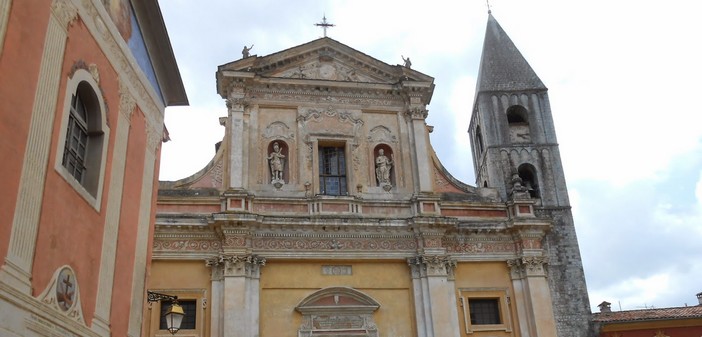A first church existed in the 12th-13th centuries, of Romanesque style, only the bell tower remains. In the 14th century, following the schism of the two Popes, there was a bishop appointed by the pontiff of Rome in Ventimiglia and a second appointed by the anti-pope of Avignon in Sospel. The two episcopal sees were not united until 1411, in Ventimiglia.
Since then, the collegiate church of Saint Michael holds the title of cathedral. You can also find the bishop’s cathedra in the choir. This Romanesque style church was located further east, on the current square and forecourt. Where the Baroque building stands, there was the old cemetery.
The new church was built after the vow of the populations to ward off an epidemic of plague. It was moved further west, on the cemetery site, which was relocated outside the village walls. Saint Michael’s was constructed between 1641 and 1762. From the old cathedral, only its Romanesque Lombard-style bell tower is preserved.
The first church was oriented west-east, facing the sunrise. The collegial cathedral of Saint Michael, with its imposing dimensions, one of the largest religious buildings in the department, was built in reverse, with the main altar facing the sunset.
This anomaly (the main altar is usually oriented either to the east, signifying renewal or resurrection, or to the north, the star of Bethlehem’s shepherds) has never been explained. Perhaps the answer lies in the first chapel of the north nave, to the right upon entering.
The altarpiece of Saint Eligius, depicts the saint with a triangle in the sky, an obvious Masonic symbol. The right apse houses numerous reliquaries. In the south nave, that is to the left, one will stop at the chapel of the deposition of Jesus with the altarpiece of the Immaculate Conception by François Brea.
The central nave with Saint Michael slaying the demon above the main altar, as well as the height of this vessel, gives an idea of the Baroque’s goals, a conception of worship where the golds are the means to elevate us towards God, a God of love and mercy, joy, and light.
The Council of Trent and Baroque art were responses to the austerity of Protestantism and the inaccessible God of the Jansenists.
Thierry Jan


